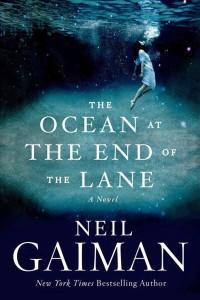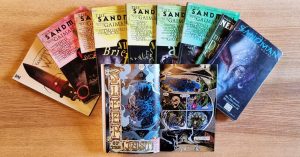In his long years of mastering the urban fantasy world, Neil Gaiman has captured the hearts of millions of readers, yours truly is definitely one of them, as, throughout the years, he has become one of my favorite authors. I have an unexplained weakness for the modern fantasy genre, which he is considered to be one of its precursors, and American Gods (you are going to hear this name a lot today) is one of my all-time favorite books. This is why I was so happy when The Ocean at the End of the Lane was first published, and why I didn’t wait too long before I purchased it. Now, I know it has been a while since it was released (almost two years, but who’s counting), but I allowed myself to skip writing about it. Actually, for the past few months, I have been feeling some kind of a phantom itch at the tip of my toes whenever I write about other books, and I am quite sure I know the reason.
If you have ever happened to read some of Neil Gaiman’s stories, you probably know they are usually built within a certain schema. The story starts with the presentation of the hero, a normal human being by all accounts, who is drawn quickly into Neil Gaiman’s unique fantasy world. Luckily for him (and for the readers), the hero is fully guided in the obscurity of the strange world he has encountered by a selected character and obviously, goes through a deep internal process that changes his perception. Yes, I know, it doesn’t sound like much when I put it this way, but the way Gaiman is building his stories and the unique worlds he is creating for them, manages to turn this seemingly simplistic and unsophisticated schema, time after time, to magical and rare literary works.
One of the significant parts in his stories and the one that affects the construction of the plot is, as I have mentioned, the passage between the worlds. But although in most of his stories the boundaries between the worlds are absolute – like the wall standing in the way of the mischievous brats in Stardust and the imaginary underground world in Neverwhere, sending the hero to the dark depths under the streets of London – in other cases, the fantasy world exists next to ours and is exposed solely to the eyes of those knowing where to look. This is how the gods’ world is revealed to the hero in Gaiman’s masterpiece American Gods, and this is the case in The Ocean at the End of the Lane, whose fault it is we have gathered here today.
The hero of this novel is an artist that comes back to the town he grew up in, somewhere in the southern plains of Sussex. The excuse for his visit is his father’s funeral. Not a bad excuse for many things, such as thinking about the past and drifting in the memories of days that are long gone. As part of his attempt to remember the old days, he finds himself driving towards the house he grew up in, or at least, what is left of it. When he reaches the house, a memory of a girl named Lettie Hempstock strikes his mind. This old memory is taking him back in time, drawing him to the little pond behind the old Hempstock’s farm-house, the small pond Lettie used to call an ocean and she tells him stories about the days she and her family sailed the ocean from the old country. From this moment on, he is drifting deep into the long forgotten memories and to his impossible childhood.
Neil Gaiman manages to squeeze all his storytelling qualities into this short book and to create an eerie, yet touching fairy tale. Although most of the plot takes place in the hero’s childhood days, this is one of the most mature, sober and sad stories that Neil Gaiman ever wrote. It is one that can easily sit on the shelf next to American Gods – his best work so far. The horror that is creeping in the shadows of the book resembles that of Lovecraft’s work, and as such, it is harrowing, leaving an uneasy feeling down the reader’s neck, but it is doing it in a gentle, almost unnoticeable way, that gives the reader a tingle of distress, without sending him into screams, running to the nearest pastor’s house.
Neil Gaiman is touching on two main issues in this book, which are naturally woven into one another – childhood and memory. How do we remember our childhood? How close is this memory to reality? Which dark secrets are hidden in our past and refuse to come out of the shadows? Do we really want to know the answers to these questions?
In short, it is one of Gaiman’s best works. Five memories and an ocean, as deep and wide as the universe itself.
The Ocean at the End of the Lane / Neil Gaiman / William Morrow and Company







